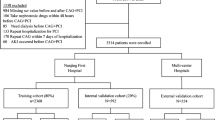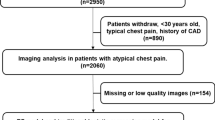Abstract
The majority of prediction models for contrast-induced nephropathy (CIN) have moderate performance. Therefore, we aimed to develop a better pre-procedural prediction tool for CIN following contemporary percutaneous coronary intervention (PCI) or coronary angiography (CAG). A total of 3469 patients undergoing PCI/CAG between January 2010 and December 2013 were randomly divided into a training (n = 2428, 70%) and validation data-sets (n = 1041, 30%). Random forest full models were developed using 40 pre-procedural variables, of which 13 variables were selected for a reduced CIN model. CIN developed in 78 (3.21%) and 37 of patients (3.54%) in the training and validation datasets, respectively. In the validation dataset, the full and reduced models demonstrated improved discrimination over classic Mehran, ACEF CIN risk scores (AUC 0.842 and 0.825 over 0.762 and 0.701, respectively, all P < 0.05) and common estimated glomerular filtration rate. Compared to that for the Mehran risk score model, the full and reduced models had significantly improved fit based on the net reclassification improvement (all P < 0.001) and integrated discrimination improvement (P = 0.001, 0.028, respectively). Using the above models, 2462 (66.7%), 661, and 346 patients were categorized into low (< 1%), moderate (1% to 7%), and high (> 7%) risk groups, respectively. Our pre-procedural CIN risk prediction algorithm (http://cincalc.com) demonstrated good discriminative ability and was well calibrated when validated. Two-thirds of the patients were at low CIN risk, probably needing less peri-procedural preventive strategy; however, the discriminative ability of CIN risk requires further external validation.
Trial registration
ClinicalTrials.gov NCT01400295.



Similar content being viewed by others
Data availability
The data that support the findings of this study are available from Jiyan Chen and Yong Liu, but restrictions apply to the availability of these data, which were used under license for the current study, and so are not publicly available. Data are however available from the authors upon reasonable request and with permission of Jiyan Chen and Yong Liu.
References
Christiansen C (2005) X-ray contrast media—an overview. Toxicology 209:185–187
Hsu RK, McCulloch CE, Dudley RA, Lo LJ, Hsu CY (2013) Temporal changes in incidence of dialysis-requiring AKI. J Am Soc Nephrol 24:37–42
James MT, Samuel SM, Manning MA, Tonelli M, Ghali WA, Faris P, Knudtson ML, Pannu N, Hemmelgarn BR (2013) Contrast-induced acute kidney injury and risk of adverse clinical outcomes after coronary angiography: a systematic review and meta-analysis. Circ Cardiovasc Interv 6:37–43
Levine GN, Bates ER, Blankenship JC, Bailey SR, Bittl JA, Cercek B, Chambers CE, Ellis SG, Guyton RA, Hollenberg SM, Khot UN, Lange RA, Mauri L, Mehran R, Moussa ID, Mukherjee D, Nallamothu BK, Ting HH (2012) 2011 ACCF/AHA/SCAI Guideline for Percutaneous Coronary Intervention: executive summary: a report of the American College of Cardiology Foundation/American Heart Association Task Force on Practice Guidelines and the Society for Cardiovascular Angiography and Interventions. Catheter Cardiovasc Interv Off J Soc Card Angiogr Interv 79:453–495
Silver SA, Shah PM, Chertow GM, Harel S, Wald R, Harel Z (2015) Risk prediction models for contrast induced nephropathy: systematic review. BMJ 351:h4395
Gurm HS, Seth M, Kooiman J, Share D (2013) A novel tool for reliable and accurate prediction of renal complications in patients undergoing percutaneous coronary intervention. J Am Coll Cardiol 61:2242–2248
Maioli M, Toso A, Leoncini M, Micheletti C, Bellandi F (2011) Effects of hydration in contrast-induced acute kidney injury after primary angioplasty: a randomized, controlled trial. Circ Cardiovasc Interv 4:456–462
Zoungas S, Ninomiya T, Huxley R, Cass A, Jardine M, Gallagher M, Patel A, Vasheghani-Farahani A, Sadigh G, Perkovic V (2009) Effects of hydration in contrast-induced acute kidney injury after primary angioplasty: a randomized, controlled trial. Ann Intern Med 151:631–638
Thayssen P, Lassen JF, Jensen SE, Hansen KN, Hansen HS, Christiansen EH, Junker A, Ravkilde J, Thuesen L, Veien KT, Jensen LO (2014) Prevention of contrast-induced nephropathy with N-acetylcysteine or sodium bicarbonate in patients with ST-segment-myocardial infarction: a prospective, randomized, open-labeled trial. Circ Cardiovasc Interv 7:216–224
Wijns W, Kolh P, Danchin N, Di Mario C, Falk V, Folliguet T, Garg S, Huber K, James S, Knuuti J, Lopez-Sendon J, Marco J, Menicanti L, Ostojic M, Piepoli MF, Pirlet C, Pomar JL, Reifart N, Ribichini FL, Schalij MJ, Sergeant P, Serruys PW, Silber S, Sousa Uva M, Taggart D (2010) Guidelines on myocardial revascularization. Eur Heart J 31:2501–2555
Nijssen EC, Rennenberg RJ, Nelemans PJ, Essers BA, Janssen MM, Vermeeren MA, Ommen VV, Wildberger JE (2017) Prophylactic hydration to protect renal function from intravascular iodinated contrast material in patients at high risk of contrast-induced nephropathy (AMACING): a prospective, randomised, phase 3, controlled, open-label, non-inferiority trial. Lancet 389:1312–1322
Briguori C, Signoriello G (2017) Acute kidney injury: intravenous hydration for the prevention of CIAKI. Nat Rev Nephrol 13:264–266
Liu Y, Chen JY, Tan N, Zhou YL, Yu DQ, Chen ZJ, He YT, Liu YH, Luo JF, Huang WH, Li G, He PC, Yang JQ, Xie NJ, Liu XQ, Yang DH, Huang SJ, Piao Y, Li HL, Ran P, Duan CY, Chen PY (2015) Safe limits of contrast vary with hydration volume for prevention of contrast-induced nephropathy after coronary angiography among patients with a relatively low risk of contrast-induced nephropathy. Circ Cardiovasc Interv 8:e001859
Liu Y, Lin L, Li Y, Li H, Wu DX, Zhao JB, Lian D, Zhou Y, Liu Y, Ye P, Ran P, Duan C, Chen S, Chen P, Xian Y, Chen J, Tan N (2015) Relationship between the urine flow rate and risk of contrast-induced nephropathy after emergent percutaneous coronary intervention. Medicine (Baltim) 94:e2258
Slocum NK, Grossman PM, Moscucci M, Smith DE, Aronow HD, Dixon SR, Share D, Gurm HS (2012) The changing definition of contrast-induced nephropathy and its clinical implications: insights from the Blue Cross Blue Shield of Michigan Cardiovascular Consortium (BMC2). Am Heart J 163:829–834
Robin X, Turck N, Hainard A, Tiberti N, Lisacek F, Sanchez JC, Muller M (2011) pROC: an open-source package for R and S+ to analyze and compare ROC curves. BMC Bioinform 12:77
Liaw A, Wiener M (2002) Classification and regression by randomForest. R News 2:18–22
DeLong ER, DeLong DM, Clarke-Pearson DL (1988) Comparing the areas under two or more correlated receiver operating characteristic curves: a nonparametric approach. Biometrics 44:837–845
Pencina MJ, D’Agostino RB Sr, D’Agostino RB Jr, Vasan RS (2008) Evaluating the added predictive ability of a new marker: from area under the ROC curve to reclassification and beyond. Stat Med 27:157–172
Cook NR (2007) Use and misuse of the receiver operating characteristic curve in risk prediction. Circulation 115:923–935
Mehran R, Aymong ED, Nikolsky E, Lasic Z, Iakovou I, Fahy M, Mintz GS, Lansky AJ, Moses JW, Stone GW, Leon MB, Dangas G (2004) A simple risk score for prediction of contrast-induced nephropathy after percutaneous coronary intervention: development and initial validation. J Am Coll Cardiol 44:1393–1399
Allen DW, Ma B, Leung KC, Graham MM, Pannu N, Traboulsi M, Goodhart D, Knudtson ML, James MT (2017) Risk prediction models for contrast-induced acute kidney injury accompanying cardiac catheterization: systematic review and meta-analysis. Can J Cardiol 33:724–736
Agarwal SK, Mohareb S, Patel A, Yacoub R, DiNicolantonio JJ, Konstantinidis I, Pathak A, Fnu S, Annapureddy N, Simoes PK, Kamat S, El-Hayek G, Prasad R, Kumbala D, Nascimento RM, Reilly JP, Nadkarni GN, Benjo AM (2015) Systematic oral hydration with water is similar to parenteral hydration for prevention of contrast-induced nephropathy: an updated meta-analysis of randomised clinical data. Open Heart 2:e000317
Brar SS, Shen AY, Jorgensen MB, Kotlewski A, Aharonian VJ, Desai N, Ree M, Shah AI, Burchette RJ (2008) Sodium bicarbonate vs sodium chloride for the prevention of contrast medium-induced nephropathy in patients undergoing coronary angiography: a randomized trial. JAMA 300:1038–1046
Luo Y, Wang X, Ye Z, Lai Y, Yao Y, Li J, Liu X (2014) Remedial hydration reduces the incidence of contrast-induced nephropathy and short-term adverse events in patients with ST-segment elevation myocardial infarction: a single-center, randomized trial. Intern Med 53:2265–2272
Brar SS, Aharonian V, Mansukhani P, Moore N, Shen AY, Jorgensen M, Dua A, Short L, Kane K (2014) Haemodynamic-guided fluid administration for the prevention of contrast-induced acute kidney injury: the POSEIDON randomised controlled trial. Lancet 383:1814–1823
Liu Y, Li H, Chen S, Chen J, Tan N, Zhou Y, Liu Y, Ye P, Ran P, Duan C, Chen P (2016) Excessively high hydration volume may not be associated with decreased risk of contrast-induced acute kidney injury after percutaneous coronary intervention in patients with renal insufficiency. J Am Heart Assoc 5:e003171
Tsai TT, Patel UD, Chang TI, Kennedy KF, Masoudi FA, Matheny ME, Kosiborod M, Amin AP, Weintraub WS, Curtis JP, Messenger JC, Rumsfeld JS, Spertus JA (2014) Validated contemporary risk model of acute kidney injury in patients undergoing percutaneous coronary interventions: insights from the National Cardiovascular Data Registry Cath-PCI Registry. J Am Heart Assoc 3:e001380
Çınar T, Karabağ Y, Ozan Tanık V, Çağdaş M, Rencüzoğulları İ, Öz A (2019) The investigation of TIMI risk index for prediction of contrast-induced acute kidney injury in patients with ST elevation myocardial infarction. Acta Cardiol 25:1–8
Çınar T, Tanık VO, Aruğaslan E, Karabağ Y, Çağdaş M, Rencüzoğulları İ, Keskin M (2019) The association of PRECISE-DAPT score with development of contrast-induced nephropathy in patients with ST-elevation myocardial infarction undergoing primary percutaneous coronary intervention. Cardiovasc Interv Ther 34:207–215
Velibey Y, Tanik O, Oz A, Guvenc TS, Kalenderoglu K, Gumusdag A, Guzelburc O, Tekkesin AI, Uzun AO, Alper AT, Eren M (2017) Off-hour primary percutaneous coronary angioplasty does not affect contrast-induced nephropathy in patients with ST-segment elevation myocardial infarction. Angiology 68:807–815
Acknowledgements
The authors would like to thank An Fan, MD in Guangdong, China for statistical support.
Funding
This study was funded by The Guangdong Provincial Cardiovascular Clinical Medicine Research Fund (Grant Number, 2009X41), Science and Technology Planning Project of Guangdong Province (Grant Number, 2014B070706010), and Cardiovascular Research Foundation Project of the Chinese Medical Doctor Association (SCRFCMDA201216). The funders had no role in the design of the study and collection, analysis, and interpretation of data and in writing the manuscript.
Author information
Authors and Affiliations
Contributions
YL, SC, JC, NT: conception and design of the work; JC, SC, YL, QL, and PC: acquisition, analysis, and interpretation of data; YL, SC, JC, PC, YX, XW, JX, NT and QL: drafting the manuscript and revising it critically for important intellectual content; JC, YL, SC, PC, YX, XW, JX, NT and QL: final approval of the version to be published. All authors read and approved the final manuscript.
Corresponding authors
Ethics declarations
Conflict of interest
The authors declare that they have no conflict of interest.
Ethical approval
All procedures performed in studies involving human participants were in accordance with the Ethical Standards of the Institutional and/or National Research Committee and with the 1964 Helsinki Declaration and its later amendments or comparable ethical standards. All participants gave their written consent to participate in the study. The study was approved by Guangdong General Hospital Institutional Ethics Research Committee.
Additional information
Publisher's Note
Springer Nature remains neutral with regard to jurisdictional claims in published maps and institutional affiliations.
Rights and permissions
About this article
Cite this article
Liu, Y., Chen, S., Ye, J. et al. Random forest for prediction of contrast-induced nephropathy following coronary angiography. Int J Cardiovasc Imaging 36, 983–991 (2020). https://doi.org/10.1007/s10554-019-01730-6
Received:
Accepted:
Published:
Issue Date:
DOI: https://doi.org/10.1007/s10554-019-01730-6




